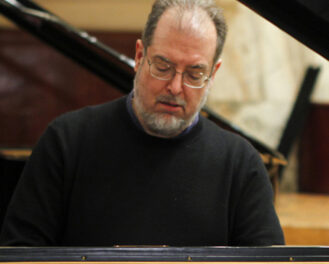The Keith Butler Trio took the stage at the Cameron Art Museum for the start of the 2015-16 series Jazz @ the CAM. Now in its sixth season, the popular series is presented jointly by the museum and the Cape Fear Jazz Society. The seven concerts feature artists from around the state in a range of jazz genres. This is just one of a variety of events offered at CAM, which has evolved into a significant cultural presenter. Along with the jazz series, the Cameron presents Pro Musica, which is a concert series devoted to music of living composers, as well as theatrical events and lectures.
The Keith Butler Trio is a rhythm section grouping of instruments: piano (Cameron Tinklenberg), bass guitar (Sean Howard) and drum set (Keith Butler). The piano serves as the main instrument, leading with the head each time and taking the bulk of the solos. This works well – Tinklenberg is a gifted improviser and a passionate player.
The character of the group was established at the start in a Bill Evans tune – “Emily.” The piano opened with a mellow presentation of the head or “thematic melody” of a jazz tune. This was accompanied by gentle brush work on the drum set. This segued into a piano solo, still mellow at first, then building substantially and eventually retreating back to a quiet sound. This was a musical plan that Tinklenberg achieved repeatedly with excellent effect. Another feature of this song that continued to recur was Tinklenberg’s quiet counterpoint around Howard’s bass solo. Hearing of interlocking lines and the ensemble sensitivity of the players stood out in such sections.
Similar components of good ensemble could be said about the following tune by John Carisi. It started out in a quiet way but with more active syncopation on the drum set. The buildup to a high point in the piano was amplified here with a high-energy, passion-filled solo that developed real intensity. Tinklenberg projected immersion and fluent, easy technique in his playing. The bass solo also developed some intensity. Howard created interesting lines but also tended to punctuate them enough that momentum did not build as strongly. In this tune, we heard Butler in a solo for the first time. He has a distinct profile as a percussionist in that he doesn’t work toward virtuosic display or high-powered sound accumulations. Rather, he focuses on the variety of rhythmic pattern. Butler is a player with whom one listens for subtler variation rather than energy or climax. Both he and Howard are different soloists in this respect compared to Tinklenberg.
The following two numbers – one a standard and one an original – both included outstanding ensemble work. The first had soft and inflected drum set playing behind the bass solo. The second, with Tinklenberg on electric piano, had an effective crescendo with all three instruments together, followed by a pullback and a launch into a new lively solo. This group is very successful as an ensemble.
After a short pause, the trio was joined by Aaron Lane on trumpet and Benny Hill on alto saxophone. Lane is a well-known player on gigs about town. Hill is a redoubtable jazz presence in Wilmington having been on the scene for perhaps twenty years now. They came together for a number which featured parallel patterns between their two instruments in the head. Lane offered a comparatively low-key solo which showed off the range of his instrument. This was unfortunately the only number on which he played. Hill showed great melodic creativity with lines that spun out at length in rich, full tone. He stayed for the final two numbers with a truly hot solo in the next-to-last tune. In the concluding “Take the A Train,” Tinklenberg seemed to just keep finding ideas and Hill projected dynamic energy with his melody playing.
The performance, especially after Lane and Hill joined in, had almost the atmosphere of a jam session being played for friends. Butler enhanced that with a winning style as MC. The audience was almost pleading for more after the final number and the band obliged with another tune. Butler could improve on his verbal presentation by speaking a bit more slowly and clearly. This listener had difficulty hearing everything, including the names of the tunes, in case they were announced. But that was a small point in this enjoyable and successful evening. This is a young trio that enjoys the music and the stage, and the audience enjoys it along with them. They carry fine artistry as both individuals and a group, and can easily be seen as one that will continue to grow in its presence on the lively Wilmington jazz scene.











